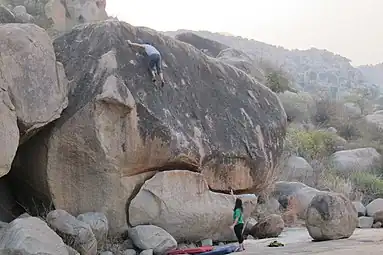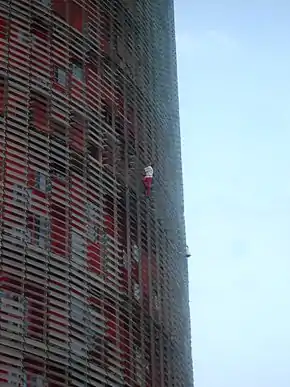| Part of a series on |
| Climbing |
|---|
.jpg.webp) |
| Lists |
| Types of rock climbing |
| Types of mountaineering |
| Other types |
| Key terms |
Solo climbing, or soloing, is a style of climbing in which the climber climbs a route alone, without the assistance of a belayer (or "second"). By its very nature, it presents a higher degree of risk to the climber, and in some cases, is considered extremely high risk (e.g. solo ice climbing, or solo big wall climbing). Note that the use of the term "solo climbing" is generally separate from the action of bouldering, which is itself a form of solo climbing, but with less serious consequences in the case of a fall. The most dangerous form of solo climbing is free solo climbing, which means both climbing alone and without any form of climbing protection.[1]
Minimal protection
The following types of "solo climbing" have minimal or no form of climbing protection, and the climber exposes themselves to potentially fatal risks:[2]
- Free solo climbing (sometimes referred to as soloing in the UK, or third-classing in the US)[2] is where the climber uses no climbing protection (or any form of climbing aid, except for their climbing shoes and their climbing chalk), and ascends a single-pitch, or a multi-pitch/big wall climbing route.[2]
- Free soloing is the most dramatic solo technique, and in 2017 became an Oscar-winning documentary film, Free Solo that featured Alex Honnold free soloing the 915-metre (3,002 ft) 35-pitch rock climbing route Freerider in Yosemite, the world's first-ever free solo of a 5.13a (7c+) big wall route in history.[3][4]
- Deep-water soloing (DWS), is a subtype of free solo climbing performed on rock faces overhanging water where in the case of a fall, the climber lands in the water.[2] Extreme deep-water solo routes can involve falls of over 20–40 metres (66–131 ft), and thus a risk of serious injury.[2] Noted DWS climbers include Chris Sharma who created the world's world's first-ever 9a+ (5.15a) DWS route, Es Pontàs, in 2007.[5]
- FreeBASEing, is a subtype of free solo climbing performed on long multi-pitch big wall routes with a BASE jumping parachute as the sole means of protection, where a falling climber opens their parachute to arrest their fall.[2] FreeBASEing was pioneered by Dean Potter who made a freeBASE ascent of Deep Blue Sea (5.12+) on the north face of the Eiger in 2008.[6][7]
- Highball bouldering, is where the boulder exceeds 7–10 metres (23–33 ft) in height, and therefore any fall, even where bouldering mats are used, presents a risk of serious injury.[2] Where highball bouldering ends and free soloing begins is a source of debate amongst climbers.[8] Notable highball boulders include Nalle Hukkataival's Livin' Large V16 (8C+) in Rocklands, South Africa.[9], and Ron Fawcett's Careless Torque 8A (V11) in Stanage Edge, England.[10]
- Free solo ice climbing can also be done in a free solo format (e.g. without any protection, such as ice screws). Notable free solo ice climbers include Canadian Marc-Andre Leclerc,[11] and Swiss ice climber, Dani Arnold, who has free soloed routes of grade WI7.[12] Related to this is the activity of mixed climbing free soloing (e.g. using ice climbing equipment on routes that are a combination of ice and rock).
- Buildering, is a subtype of free solo climbing where the climber ascends a public building (or mechanical structure with crane climbing), which is usually performed without any protection.[2] Notable building climbers include Alain Robert (who also made world's first-ever free solo of an 8b (5.13d) rock climbing route), who has free soloed several major buildings including the Eiffel Tower and the Burj Khalifa.[13]
Full protection
The following types of "solo climbing" have a form of climbing protection, involving mechanical self-locking (or progress capture/assisted braking) devices, which significantly reduces the risk of serious or fatal injury to the climber:[2]
- Rope solo climbing is climbing alone but with a rope to help arrest a fall, or for a self-rescue if required.[2][14] Instead of having a belayer, the climber uses a self-locking device that will hold the rope in the case of a fall, and leads the route in a traditional climbing manner, placing climbing protection as they ascend. One end of the rope is anchored below the climber and the climber pays-out the rope through the self-locking device as they ascend. Once they reach the top, they need to abseil down and re-ascend the route with an ascender, to remove the protection they placed earlier.[15]
- In 1992, French climber Catherine Destivelle used such a self-locking device to rope-solo the first part of the traditional climbing route El Matador 5.10d (6b+), on the Devils Tower in Wyoming (she free soloed the second part), and was captured in the climbing film, Ballade à Devil's Tower.[16] In 1992, Destivelle used the rope solo technique to create Voie Destivelle (VI 5.11b A5) on the west face of the Petit Dru, and was captured in the climbing film, 11 Days on the Dru.[17] In 2016, Pete Whittaker rope-soloed the 915-metre (3,002 ft) 35-pitch route Freerider in Yosemite in a single day.[15]
- Top rope solo climbing is a form of top roping where a single static fixed rope, anchored to the top of the route, is laid along the length of the climb. The climber then clips-into the fixed rope using at least one progress capture device (PCD) such as a Petzl Micro Traxion or a Camp Lift, that will allow the rope to pay-through as the climber ascends but will grip the rope tightly in the event of a fall.[18][19]
- Auto belay indoor climbing is usually a form of top roping (although there are lead auto belay devices) where the belayer is replaced by a mechanical device permanently fixed the top (or bottom for lead auto belay) of the route.[20]
In film
A number of notable films have been made focused on solo (and free solo) climbing (on rock and/or on ice) including:[21]
- The Alpinist, a 2021 documentary film about Canadian alpinist Marc-André Leclerc, featuring various solo, and free solo, of rock, ice and alpine routes.
- Free Solo, a 2018 Netflix documentary film about Alex Honnold's free solo climb of Freerider 5.13a (7c+) on El Capitan.
- King Lines, a 2007 documentary film about Chris Sharma, featuring his free solo climb of the DWS route, Es Pontàs 9a+ (5.15a), in Mallorca.
Gallery
![Natalija Gros [sl] deep-water soloing in Croatia](../I/Natalija_Gros_in_Kamenjak%252C_Croatia%252C_2009_photo_Jure_Breceljnik.jpg.webp) Natalija Gros deep-water soloing in Croatia
Natalija Gros deep-water soloing in Croatia Highball bouldering, in Hampi, India
Highball bouldering, in Hampi, India![Heinz Zak [de] free soloing Separate Reality, in Yosemite National Park, California](../I/Heinz_Zak%252C_Separate_Reality_5%252C11d%252C_Free_Solo%252C_Yosemite-Nationalpark%252C_Kalifornien%252C_USA.jpg.webp) Heinz Zak free soloing Separate Reality, in Yosemite National Park, California
Heinz Zak free soloing Separate Reality, in Yosemite National Park, California Alain Robert buildering Torre Glòries, Barcelona
Alain Robert buildering Torre Glòries, Barcelona
See also
- Aid climbing, where the climber uses mechanical aids to help ascend a route (i.e. not just for protection)
- Traditional climbing, which requires the climber to place their climbing protection during the climb
- Sport climbing, that uses pre-placed bolted climbing protection
References
- ↑ Long, John; Sponholz, Hai-Van K. (1999). The High Lonesome: Epic Solo Climbing Stories. Adventure Series: Falcon guide. Globe Pequot. p. 1. ISBN 9781560448587.
- 1 2 3 4 5 6 7 8 9 10 Osius, Alison (4 June 2022). "Free Solo Rock Climbing and the Climbers Who Have Defined the Sport". Climbing. Retrieved 26 November 2022.
- ↑ "Exclusive: Climber Completes the Most Dangerous Rope-Free Ascent Ever". National Geographic Society. 3 June 2017. Archived from the original on June 3, 2017.
- ↑ Mcphate, Mike (2017-06-06). "California Today: An 'Incomprehensible' Climb in Yosemite". The New York Times. ISSN 0362-4331. Retrieved 2017-06-06.
- ↑ "A History of Mallorca Deep Water Soloing". British Mountaineering Council. 8 March 2011. Retrieved 21 December 2021.
- ↑ Thomasma, Melissa (13 August 2008). "FreeBASE: Dean Potter on the Eiger Nordwand". Alpinist. ISSN 1540-725X. Retrieved 30 December 2022.
- ↑ Bisharat, Andrew (18 May 2015). "How Dean Potter Reinvented Climbing, Jumping, Flying". National Geographic. Archived from the original on May 20, 2015. Retrieved 30 December 2022.
- ↑ Edwards, Pete (November 2020). "Is it Highball Bouldering? Or should we be calling it Free-Soloing". Retrieved 30 December 2022.
- ↑ "Shawn Raboutou Climbs Hukkataival's Highball "Livin' Large" in Rocklands". Rock & Ice. 8 October 2019. Retrieved 28 January 2022.
- ↑ "Careless Torque (8a), Stanage Plantation, Peak District, UK". Climbing. 16 November 2009. Retrieved 30 December 2022.
- ↑ "Who Was Marc-André Leclerc? The Incredible Solo Climber Of The Alpinist". Climbr. 2 January 2022. Retrieved 8 May 2023.
- ↑ Luthiger, Valentin (28 January 2018). "Dani Arnold Free Soloing a 1,000-Foot WI 7 Ice Climb". Retrieved 8 May 2023.
- ↑ Pilastro, Eleonora (6 December 2022). "The Real Spider-Man: Alain Robert climbs the world's tallest buildings". Guinness Book of Records. Retrieved 30 December 2022.
- ↑ Tyson, Andy; Loomis, Molly (2006). Climbing Self-rescue: Improvising Solutions for Serious Situations. Mountaineers Outdoor Expert Series. The Mountaineers Books. p. 120. ISBN 9781594851582.
- 1 2 Franz, Derek (18 November 2016). "Pete Whittaker rope solos El Cap's Freerider all free in a day". Alpinist. Retrieved 30 December 2022.
- ↑ "Watch Catherine Destivelle Free-Solo Devils Tower". Gripped. 16 March 2021. Retrieved 10 December 2022.
One of the most rad free-solos caught on film in the 1990s
- ↑ Stefanello, Vinicio (24 July 2017). "Catherine Destivelle, climbing and alpinism there where it is dangerous to lean out". PlanetMountain. Retrieved 11 December 2022.
- ↑ Wharton, Josh (25 August 2022). "Top-rope soloing: How Josh Wharton Climbs Multi-pitches Faster and With Less Energy". Climbing. Retrieved 5 March 2023.
- ↑ Black, Christian (3 February 2022). "Rope Solo Rock Climbing: Understanding How It's Done". GearJunkie. Retrieved 3 March 2023.
- ↑ Achs, Jordan (2 July 2016). "No Belayer Necessary: Understanding Autobelays". Climbing. Retrieved 2 October 2023.
- ↑ Bisharat, Andrew (6 September 2022). "The 20 Best Climbing Films of All Time". Outside. Retrieved 28 September 2023.
External links
- Free Climbing vs Free Solo vs Solo Climbing, HardClimbs (2023)